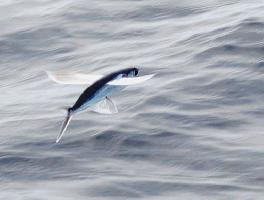
Váhy a míry
| Délka | 32 cm |
|---|
Popis zvířete
The Atlantic flyingfish (Cheilopogon melanurus) is a fascinating species that captures the imagination with its unique ability to glide through the air, momentarily escaping its aquatic confines. This remarkable fish belongs to the family Exocoetidae, which encompasses about 64 species known for their aerial prowess. The Atlantic flyingfish, in particular, has adapted to an extraordinary lifestyle that bridges the realms of both sea and sky, making it a subject of curiosity and study among marine biologists and nature enthusiasts alike.Physical Description
Typically, the Atlantic flyingfish possesses a streamlined body that facilitates its swift movement through water. This sleek design is complemented by a silvery-blue hue on the dorsal side and a shimmering silver on the ventral side, allowing it to blend seamlessly with the water's surface, evading predators both from the deep and from above. One of the most striking features of Cheilopogon melanurus is its large, wing-like pectoral fins, which span much of its body length. These fins are the key to its gliding capabilities. When the fish accelerates and breaches the water surface, it spreads its pectoral fins wide, catching the air and propelling itself forward. In addition to the pectoral fins, its smaller pelvic fins also aid in stabilization during flight.
Size and Lifespan
An adult Atlantic flyingfish can reach lengths of up to 25 centimeters (about 10 inches), although sizes can vary among different populations. Information on their lifespan in the wild is somewhat limited, but like many small fish, they are thought to have relatively short life cycles, possibly living a few years, depending on environmental conditions and predation pressures.
Habitat and Distribution
The Atlantic flyingfish is found in warm oceanic waters, particularly in the Atlantic Ocean. Its range extends from the eastern coast of North America, including the Gulf of Mexico and the Caribbean, to the western coasts of Africa and Europe. It prefers surface waters where it can easily access air for its gliding escapades and where its food sources—primarily plankton, small crustaceans, and other tiny marine organisms—are abundant.
Behavior and Ecology
One of the most remarkable aspects of the Atlantic flyingfish's behavior is its ability to "fly." When threatened by predators such as tuna, dolphinfish, and various seabirds, it can burst out of the water at speeds of up to 60 km/h (37 mph). Once airborne, it can glide for considerable distances—up to 200 meters (656 feet)—using its tail to make adjustments and prolong its flight. This evasive maneuver is not only a spectacle but also a testament to the incredible adaptations that have evolved in the marine environment.
Reproduction
The reproductive habits of the Atlantic flyingfish involve the release of eggs and sperm into the water, where fertilization occurs externally. The eggs are buoyant and are often attached to floating debris or sargassum seaweed, providing some protection from predators. This association with floating objects also facilitates the distribution of the species across vast oceanic distances.
Conservation Status
Currently, the Atlantic flyingfish is not considered endangered or under significant threat. However, like many marine species, it faces challenges from habitat degradation, climate change, and accidental capture in fisheries targeting other species. Monitoring and understanding the impacts of human activity on its populations are crucial for ensuring that this extraordinary fish continues to grace the world's oceans with its aerial acrobatics.
In conclusion, the Atlantic flyingfish (Cheilopogon melanurus) is a marvel of the natural world, embodying the incredible diversity and adaptability of life on Earth. Its unique lifestyle, spanning the domains of both air and water, continues to intrigue and inspire, reminding us of the wonders that lie just beneath the waves.
Nové fotografie zvířat
Top 10 zvířat
- Chinese water dragon (Physignathus cocincinus)
- Galápagos tortoise (Geochelone nigra complex)
- Dolphin gull (Leucophaeus scoresbii)
- Japanese macaque (Macaca fuscata)
- Colombian red howler (Alouatta seniculus)
- Sea urchins (Echinoidea)
- Moustached guenon (Cercopithecus cephus)
- Diana monkey (Cercopithecus diana)
- Common reed warbler (Acrocephalus scirpaceus)
- Common house mosquito (Culex pipiens)